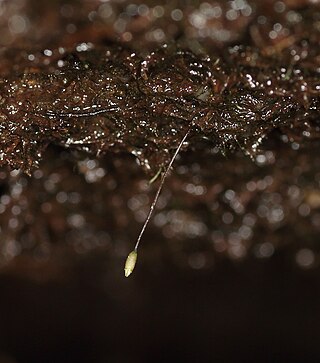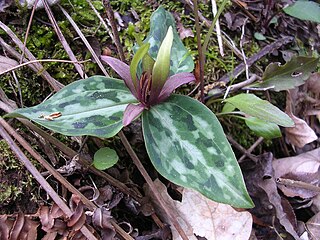Related Research Articles

Trillium is a genus of about fifty flowering plant species in the family Melanthiaceae. Trillium species are native to temperate regions of North America and Asia, with the greatest diversity of species found in the southern Appalachian Mountains in the southeastern United States.

Spanish moss is an epiphytic flowering plant that often grows upon large trees in tropical and subtropical climates. It is native to much of Mexico, Bermuda, the Bahamas, Central America, South America, the Southern United States, and West Indies. It has been naturalized in Queensland (Australia). It is known as "grandpa's beard" in French Polynesia.

Sassafras is a genus of three extant and one extinct species of deciduous trees in the family Lauraceae, native to eastern North America and eastern Asia. The genus is distinguished by its aromatic properties, which have made the tree useful to humans.

Quercus virginiana, also known as the southern live oak, is an evergreen oak tree endemic to the Southeastern United States. Though many other species are loosely called live oak, the southern live oak is particularly iconic of the Old South. Many very large and old specimens of live oak can be found today in the Deep South region of the United States.

Erythronium propullans, the Minnesota dwarf trout lily, Minnesota adder's tongue or Minnesota fawnlily, is a rare plant endemic to the Cannon River and North Fork Zumbro River watersheds in Rice County, Goodhue County and the extreme northern edge of Steele County, Minnesota, in the United States. The plants are believed to be a mutation or sport of the white trout lily and evolved following the most recent ice age. It was listed as an endangered species of the United States under the Endangered Species Act in 1986.

Sabal palmetto, also known as cabbage palm, cabbage palmetto, sabal palm, blue palmetto, Carolina palmetto, common palmetto, Garfield's tree, and swamp cabbage, is one of 15 species of palmetto palm. It is native to the Southern United States, the Yucatán Peninsula in Mexico, and the West Indies.

Clintonia uniflora, commonly known as bride's bonnet, queen's cup, or bead lily, is a species of flowering plant in the lily family Liliaceae. The specific epithet uniflora means "one-flowered", a characteristic that distinguishes this species from others in the genus Clintonia. For this reason, it is also known as the single-flowered clintonia.

The flora of Scotland is an assemblage of native plant species including over 1,600 vascular plants, more than 1,500 lichens and nearly 1,000 bryophytes. The total number of vascular species is low by world standards but lichens and bryophytes are abundant and the latter form a population of global importance. Various populations of rare fern exist, although the impact of 19th-century collectors threatened the existence of several species. The flora is generally typical of the north-west European part of the Palearctic realm and prominent features of the Scottish flora include boreal Caledonian forest, heather moorland and coastal machair. In addition to the native species of vascular plants there are numerous non-native introductions, now believed to make up some 43% of the species in the country.

Ceratodon purpureus is a dioicous moss with a color ranging from yellow-green to red. The height amounts to 3 centimeters. It is found worldwide, mainly in urban areas and next to roads on dry sand soils. It can grow in a very wide variety of habitats, from polluted highway shoulders and mine tailings to areas recently denuded by wildfire to the bright slopes of Antarctica. Its common names include redshank, purple forkmoss, ceratodon moss, fire moss, and purple horn toothed moss.

Tetrodontium brownianum is a species of moss commonly known as Brown's tetrodontium moss or Brown's four-tooth moss. It is widely distributed. In North America it is found in Washington state and British Columbia on the west coast and from Newfoundland to Ohio to the east. It is also present in Austria, France, Germany, Ireland, Norway, Sweden, Switzerland and the United Kingdom as well as Japan, New Zealand and Chile.

Trillium albidum is a species of flowering plant in the bunchflower family Melanthiaceae. It is the only trillium characterized by a stalkless white flower. The species is endemic to the western United States, ranging from central California through Oregon to southwestern Washington. In the San Francisco Bay Area, it is often confused with a white-flowered form of Trillium chloropetalum. In northern Oregon and southwestern Washington, it has a smaller, less conspicuous flower.

Trillium reliquum, the relict trillium, Confederate wakerobin, or Confederate trillium, is a monocotyledon species of the genus Trillium, a perennial, flowering, herbaceous plant of the family Liliaceae. It is found only in the southeastern region of the United States: southwest, central and east central Alabama, Georgia, South Carolina and Tennessee. As a relict species, there are a few remaining groups but it was once more abundant when conditions were different. Significant habitat loss has occurred through clearing of forests for agricultural and pine farm uses.

Leucobryum is a genus of haplolepideous mosses (Dicranidae) in the family Leucobryaceae. The name comes from the Greek leukos, meaning white, and bryon, meaning moss.

Plagiomnium cuspidatum, also known as toothed or “baby-tooth” plagiomnium moss and woodsy thyme-moss, is a species of thyme-moss that originated in North America, but can now also be found throughout Middle America, Africa, Northern and Southern Asia, and Europe.

Orthotrichum lyellii, also known as Lyell's bristle moss, is a species of acrocarpous moss belonging to the family Orthotrichaceae. O. lyellii can be found throughout western North America and Europe. It is found most commonly growing epiphytically on a variety of trees, and less commonly on rocks or boulder substrates.

Ulota crispa, the crisped pincushion moss, is a species of acrocarpous moss in the genus Ulota native to eastern North America. It is generally found in tight mounds on tree bark.

Polytrichum piliferum, the bristly haircap, is an evergreen perennial species of moss in the family Polytrichaceae. The bristly haircap moss is small-sized to medium-sized and forms loose tufts with wine-reddish stems. It is an acrocarpous moss that appears bluish-green to grey. This moss grows in clumps on erect shoots and becomes a red-brown colour as it grows older. The most distinguishing feature of P. piliferum is the long, white awn at the tips of the leaves, which also give this moss its grey colour. It is the only species in its genus where the awn is completely hyaline.
Polytrichum hyperboreum is a species of moss belonging to the genus Polytrichum, commonly found throughout arctic regions of the world. Members of this dioecious species readily produces sporophytes with their sporophytic structure, consisting of a foot, seta, capsule, and a hairy calyptra, similar to other Polytrichum species. Polytrichum hyperboreum is distinguishable by certain unique features of there gametophytic structure that sets them apart from other genus members.

Sphagnum contortum is a species of moss reported in North America and Europe. NatureServe marked its global conservation status as Secure.
References
- ↑ "White Moss - Leucobryum albidum". I Naturalist. Retrieved 2019-06-13.
- ↑ "Leucobryum albidum". Atlas of Florida Plants. Retrieved 2019-06-13.
- ↑ "Leucobryum albidum". eFloras - Flora of North America. Retrieved 2019-06-13.
- ↑ "Leucobryum albidum". Coniferous Forest Bryophytes. Retrieved 2019-06-13.
- ↑ "Leucobryum albidum - FNA". floranorthamerica.org. Retrieved 2021-07-09.
- ↑ "NatureServe Explorer 2.0". explorer.natureserve.org. Retrieved 2021-07-09.
- ↑ "Coniferous Forest Bryophytes". www.esf.edu. Retrieved 2021-07-09.